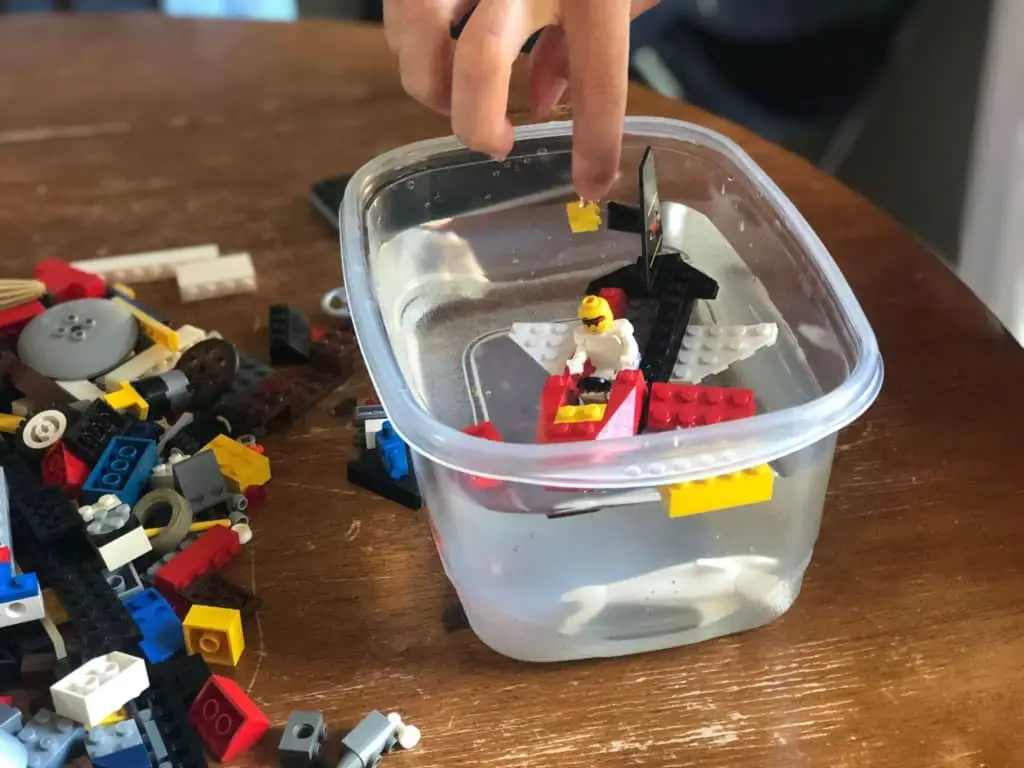
If you love to play or run experiments with Legos, you may have wondered ‘do Legos float?’. Being a Lego fan myself, I have explored a lot and figured out how the floating tricks actually work. So, let’s start with the fundamental question: do legos float?
Lego bricks and Lego boats will often float, but not always. Legos are made of ABS plastic, which is slightly more dense than water and does not float by itself. However, some Lego bricks (and boats) are able to float when they have the right buoyancy, density, and surface tension.
As you can see, in order to properly answer whether Legos can float, we need to understand a little bit of science. Don’t worry though, in the following few sections we’ll break it down in simple terms. Here’s what we’ll cover next:
Table of Contents
Do Legos Float?

As we mentioned, most Lego bricks are made of ABS plastic. The density of this material is slightly more than water, hence they do not float (all else being equal).
But here’s where it gets interesting…
Lego bricks with a hollow underside can accumulate air bubbles. As a result, the buoyancy can be significantly improved. So, even though solid blocks of ABS plastic would sink, it is possible for hollow Lego bricks to float.
In addition, some Lego pieces will be more likely to float compared to others. For example, a wide thin piece will typically have a better chance of floating compared with a narrow bulky brick, due to surface tension.
Another interesting thing to consider is whether the bricks will float upright.
Depending on the shape and size, a Lego piece (or a Lego build) may tend to float upright, tilt sideways, or it may sink. This is related to something called the center of buoyancy, or center of mass. It determines how stable or balanced the object is in the water.
This is a bit of a different scenario, but there are also Lego bricks made of foam.
Foam Lego bricks are designed to float. These are especially great for young kids as regular Legos can sometimes be a hazard for small children. Check out the below video, where the kids got some terrific ideas to take advantage of the giant floating Lego bricks!
It’s also important to note that Lego is transitioning to more sustainable alternatives to plastics to make all its bricks ‘green’ by 2030.
As they do this, some of their products have been discontinued, whereas novel products are coming in. As the pieces transition to different materials, this may affect flotation.
Now let’s talk about Lego boats.
Do Lego Boats Float?
Lego boats will float when constructed properly. Just like a real boat, if the hull (or inside) of a Lego boat is watertight, and the design of the vessel provides the proper buoyancy, it will float.
Check out this cool video, where a bunch of LEGO boats are put to the test!
Digging deeper, here are some more key points to consider regarding whether a specific Lego boat will float or not:
- If the design allows water to enter inside, the boat can eventually become heavy and sink. Having a proper water drainage system or high sides in the boat can do the trick!
- The weight of the boat should be evenly distributed, otherwise, the boat may capsize and/or sink.
- Using long flat wings at both sides of the boat can enhance the advantage of surface tension and buoyancy, helping your Lego boats float.
- Lego boats with wider hulls (i.e. larger surface area) have better chances to keep the boat upright during floating, narrow hulls can easily become top-heavy and sink.
- Lego offers specially sealed boat hulls, which can help you to build a floating boat without the risk of water penetration.
After considering the above, I think it all raises an interesting question: are legos watertight?
Are Legos Watertight?

Individual standard Lego bricks are watertight and will not be harmed by water. Lego also offers specialized items that are intended to float, such as boat hulls.
But, parts made of an assembly of small pieces as well as mechanical components such as Technic gearbox or DUPLO® vehicles are not watertight, so water can go in through the connection points.
Some Lego fans use clear silicone sealant to make the connections or cracks watertight. And some people recommend using liquid latex in between the bricks.
However, I’m not a sealant guy. I like to use the Legos as they were originally intended, without any sealant or Krazy Glue (also known as the “Kragle” to fans of The Lego Movie).
If you do decide to use glue/sealant, choose it carefully, to avoid any toxic or potentially dangerous or abrasive substances. Especially if kids are going to be using it.
The Science Behind Floating Legos
There are lots of cool videos available on YouTube, where they test if their Lego boats float or fail. The main difference among all these Lego boats is their design or model. Here’s another cool example:
So, what is actually going on here?
Let’s dig into the science in more detail, so that we can keep our knowledge afloat (see what I did there?).
Density
In simple terms, density is the amount of matter in an object with respect to the space it takes up; often measured as mass per volume.
In general, heavier objects should sink whereas lighter objects should float. For example, an iron bar will easily sink, while a leaf will float on the water. However, this is not always the case!
For instance, think about ships and boats. Although they are heavy, their mass is much less than their size, which is why they can float.
Coming to Legos, their density can also be reduced by making the material hollow. If Legos have enough pockets to trap air bubbles, their mass will feel much lighter compared to their size. Thus reduced density can help Legos float.
Buoyancy
As we talked about reduced density, this introduces the next factor, buoyancy. This is the ability of an object to float in fluids, such as water or air. The buoyancy of Legos not only depends on their density but also on the amount of water they can displace.
If a Lego piece can displace more water than its weight, it will float. This is called a positive buoyancy. If the amount of displaced water is less, then it will result in negative buoyancy, i.e., the Lego will sink.
Nonetheless, if the displaced water weighs exactly the same as the Lego, it will lead to neutral buoyancy, and the object will neither float, nor sink. This means, the object will sink beneath the water’s surface, but will not sink all the way to the bottom.
The shape of the object is also critical in this case. The hull of the ships or boats is designed in such a way that these vessels can push a large amount of the water, thus enhancing their buoyancy. You can learn more about it in this article if you are interested.
Surface tension
Think about a water strider that can glide across the water. How do you think it’s possible? This is a perfect example of surface tension. Water molecules are attracted to each other and hence these molecules kind of form a membrane on the surface of the water which helps objects to float.
So, Legos will float on the surface of the water as long as they cannot break through the top layer, i.e., the barrier of the water’s surface. If they are not balanced or stable, they may slant; hence break the surface tension barrier and begin to sink.
Safety with Wet Legos
It’s also important to note that, although immersion of Lego bricks in water would not inherently be a problem, it could lead to the growth of mold and mildew, which is a potential health risk.
So, be mindful to properly dry the parts after they’ve gotten wet. And here is how you should clean your Legos.
In addition, Lego strictly prohibits contact of any electronic parts such as motors, sensors, lights, and battery boxes with water.
In Conclusion
Now that you know the science behind floating Legos, you can understand that Legos definitely can float, but they don’t in all cases.
All the factors discussed above will contribute to making your Legos float successfully (or not!). So, choose your Lego pieces wisely, or build your own floating Lego vessel in a smart and epic way!
Related Questions
Do Legos Melt?
LEGOs aren’t likely to melt under normal conditions, but they can melt in extreme heat. Most modern LEGO bricks are made from ABS plastic, which has a melting point of 221⁰F (105⁰C). And at 320⁰F (160⁰C), LEGOs will have surpassed the melting point and the plastic will be liquified.
Are Legos Compatible With Mega Construx (Or Mega Bloks)?
Legos are generally compatible with Mega Construx and Mega Bloks. However, the Mega brand tends to make lower quality (or less consistent) bricks. When using Mega Construx with Legos, you will sometimes find pieces that don’t fit quite right, because of small differences in the size, shape, or quality.
